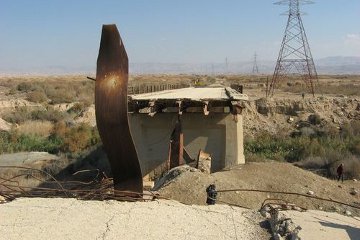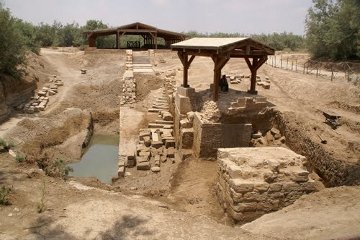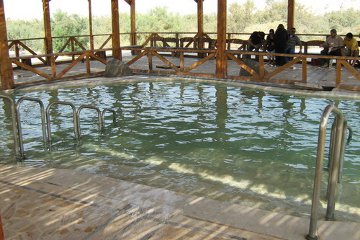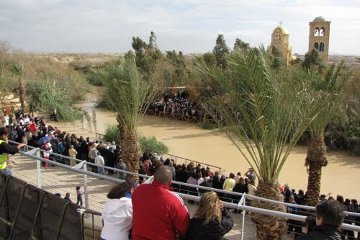Bethany-beyond-Jordan
| Traditional baptism site | 31 50 13.40N 35 32 47.25E | The golden church on the Jordanian side is clearly visible, as is the newly discovered archaeological site further east, but the Jewish side is pixillated, probably deliberately. |
| Bethany-beyond-Jordan | 31 50 13.48N 35 33 01.01E | The coordinates are of the pool that is claimed to be the actual baptismal site. |
| Bethany Visitor Centre | 31 50 44.74N 35 34 39.49E | The attractive buildings of the visitor centre fit harmoniously with their wilderness surroundings. Pilgrims and tourists are encouraged to walk the mile down to the baptismal site, but an electric minibus is available for those unable to do so. |
| King Hussein Bridge | 31 48 03.82N 35 32 47.50E | The picture clearly shows the bridge with its damaged approaches and the ruined road on the Jordanian side of the river. If the traditional site is incorrect, then this is an attractive alternative. |
Traditional sites are all very well, but when it comes to accepting them at face value, the amount of salt required varies from the customary "grain" to several liberal shovel-fulls! The silver star that marks the "actual birth place" of Jesus is tucked away in such a tiny alcove that the Virgin Mary must have been a contortionist to have given birth on that spot. We were similarly sceptical in 1958 when our guide pointed to a particular rock in the grounds of the St Peter Gallicantu church and assured us that it was the very spot where the cock stood as it crowed after Peter's denial of Christ.

| |
| The River Jordan near Bethany-beyond-Jordan runs through heavily wooded steep-sided banks. |
Such, I fear, is the attitude I bring to the traditional site of Jesus' baptism. Located on the banks of the Jordan river a short distance from Jericho, the site was marked in those days by a somewhat dilapidated Greek Orthodox church, an extremely dilapidated wooden platform standing in the water and an unusual number of police. Enquiries revealed that the day before an American tourist had ventured onto the platform and fallen in and the police were still hunting for his body!
That somewhat prejudiced us against the traditional site: it was hardly likely, we felt, that John the Baptist would have attracted many converts if every second or third one had been swept away and drowned! After taking a photograph or two of the muddy stream flowing between the steep banks we departed to look for a more likely spot and eventually found one a mile or so south where the banks of the river fell away and the river itself spread out to a broader, more placid stream that was no more than waist-deep.

| |
| The King Husein Bridge, destroyed during the 1967 war, crosses the Jordan river near a convenient ford where John might have preached. |
Not only was this a more suitable spot for the ceremony of baptism, we felt, but as a place where the river could be forded it was also a morely likely location for an aspiring preacher. Travellers journeying between Palestine and the Decapolis would seek to cross the river where it was safe to do so and might well be tempted to linger while they watered their beasts in preparation for the desert ahead. They would thus be an easy target for John and his preaching. The fact that Qumran, the possible community from which John had obtained the idea of baptism, was visible a short distance away through the haze was another attraction.
According to the Bible, at the time of Jesus' baptism John was in a very specific location.
These things were done in Bethabara beyond Jordan, where John was baptising.
John 1:28 (KJV)This all happened at Bethany on the other side of the Jordan, where John was baptising.
John 1:28 (NIV)
The Greek text actually states "Bethany", but by the time people came to consider the question there was no site known as "Bethany" near the Jordan. Origen, a Christian who lived in Palestine around AD 200, suggested that John had made a mistake (or copyists had written in the wrong name) and the location should actually be "Bethabara". This solution was adopted so enthusiastically that it became enshrined in the King James Version of the Bible and generations of preachers have unthinkingly identified Bathabara as the site of Jesus' baptism.
In 1877 a British army officer named C. R. Conder, who surveyed and mapped Palestine for the Palestine Exploration Fund, proposed that Bethabara should be identified with Makhadet 'Abara in the north, near Bethshean. Unfortunately although the name sounds familiar and there is adequate water at Makhadet'Abara, the site itself is a mile from the river and is intensively cultivated - hardly the desert place implied by the records in the gospels. Finally, Makhadet 'Abara is on the west bank of the Jordan and hardly qualifies for the description "beyond Jordan".

| |
| The recently excavated pool at Bethany-beyond-Jordan, which many consider to be the actual site of Jesus' baptism. |
Various other suggestions have been advanced, including even that "beyond Jordan" is a mistake and Jesus was really baptised at the better-known Bethany near Jerusalem! All of them are more or less unlikely and in some cases - like the site suggested by one scholar that turned out to be 3,000 feet above the Jordan valley - so implausible that you really wonder how anyone could take it seriously!
Clemens Kopp in his book, Holy Places of the Gospels, puts forward the suggestion that "Bethany" might be derived from bet anniyah, "the house of the boat". He points out that the Madeba mosaic map shows two lines across the Jordan beneath which are a boat and suggests that these represent a ferry across the river which was propelled by hauling on a fixed rope. This points to the traditional site of the baptism, which would certainly require a ferry.
In addition, the Pilgrim of Bordeaux (AD 333) locates the site of Jesus' baptism as five Roman miles north of the Dead Sea. ("Thence to the Jordan, where the Lord was baptised by John - miles V.") This again points to the traditional site, which is approximately five miles from the modern north shore of the Dead Sea and was probably less back in those days. (Five Roman miles would be about four and a half modern miles.)
The modern church - which replaces the building we first saw - stands on the east bank of the Jordan in Jordanian territory. On the opposite bank, in Israeli territory, is a crenellated structure known as Qasr el-Yahud or "the Jews' Castle". It is believed to be built on the ruins of a monastery erected by the Byzantine emperor Anastasius. The presence of the monastery, together with fear of marauding Arabs, led pilgrims to be satisfied with a visit to the west bank of the river and gradually the east bank, which alone can be described as "beyond Jordan", was forgotten.

| |
| The modern baptismal pool at Bethany-beyond-Jordan is available for all Christian denominations which practise immersion. |
It was the Six-day War which revived interest in the east bank, for the Israeli occupation of the west bank meant that Arab Christians were no longer able to visit the west bank site. At first Bethany-beyond-Jordan was also impossible to visit; it was so close to the river that divided the two countries that both sides regarded visitors with suspicion and tended to shoot first and ask questions afterwards.
The situation changed with the 1994 peace treaty between Jordan and Israel, which not only allowed pilgrimages to recommence, but also provided opportunity for archaeological investigation. Although earlier surveys of the area had dismissed it as Byzantine, a more detailed survey conducted by the Jordanian Department of Antiquities revealed a settlement dating from the early Roman era and which grew, by Byzantine times to a substantial town that stretched for two and a half miles along the river bank!
Significantly, excavations which began in 1996 have uncovered the remains of several churches and some large rectangular pools, at least one of which was approached by steps, which might indicate that it was used by many people simultaneously. If that interpretation is correct, then it points to a ritual use with pilgrims flocking in to immerse themselves in the course of a religious festival.

| |
| Up to 20,000 people can visit the baptismal site during the Feast of Ephiphany. |
There is now a path which visitors can follow that leads past many of these new discoveries. There are the ruins of several churches, in which a few scatterings of mosaic flooring can still be seen; there are the pools mentioned above; there are even a couple of hermits' caves where monks spent their time in prayer. Unfortunately, it is still not possible to have a baptism in the Jordan river itself. You can walk right down to the water's edge, but any attempt to get into the water gets a hostile reaction from the Israeli side! Instead pilgrims have to use small font near the bank or, if they prefer full immersion, there is an attractive pool filled with Jordan water a short distance away.
The situation is less happy on the west bank, where access to the river is strictly controlled. Pilgrims are allowed to visit at the Feast of Epiphany, but that is about all and recently (2011) even that was stopped on the grounds that the government needed to conduct health tests on the water. Some suspect that the health tests are simply an excuse for further discrimination against Christians by the Jewish authorities; it is notable that whereas the Jordanians spent two years clearing the mines that had been laid on their side of the river, there are still signs warning of mines all along the Israeli side.
This contrasts with the Muslim Jordanians who have treated their site with a respect that is wholly commendable. The excavated churches have been protected with shelters; no tatty commercial development is allowed within the area, which has been declared a nature reserve; the visitor centre is a mile from the holy sites themselves to avoid trespassing on their sanctity, and electric vehicles have been provided to transport visitors to the river.
We run archaeological tours of the Middle East (see www.diggings.co.uk/pages/tour.htm), not pilgrimages, and our emphasis is on accurate historical information, not on devotional exercises - though we always allow opportunity for those who wish to pray to do so. However on almost every tour there is someone who wishes to mark their visit to the Jordan in some special way, either by being baptised or by renewing their baptismal vows and we are happy to make this possible. That is why, on our trip to Jordan, we stop at Bethany-beyond-Jordan. There is enough archaeology to make the non-religious happy - and the chance to stretch one's legs by the riverside is not to be missed - and for the religious it is an occasion that will never be forgotten.
Alas, tradition - even ones that turn out to be correct - can get carried away! Up in Nazareth there is the now ruined Church of Our Lady of the Fright, which allegedly marks the very spot where Mary was standing when she saw the mob hustling Jesus out of the synagogue and feared for His safety. Similar inventiveness has been at work down by the Jordan. Arculf, a pilgrim who visited the Holy Land in AD 670 records that when he visited the baptismal site, not only was there a wooden cross in the water marking the exact spot of Jesus' baptism, but there was even a chapel on the bank, erected over the place where Jesus placed His clothes before entering the water!
amount of salt For those not used to English and its idioms, when one is expressing doubt about something, a common expression is "I'll take that with a grain of salt". Apparently the phrase comes from a Latin original - cum grano salis - where also it means that what is being said should not be taken too seriously. Return
Travellers The convenience of the spot was proved when we returned in 1967 and discovered that in the meantime the Jordanians had built a bridge across the Jordan to replace the rusting baily-bridge constructed by General Allenby some forty years before. We paused for a swim in the cool water before continuing on to Jerusalem - and a week or so later were almost the last people to cross the bridge in the opposite direction when the Six-day War broke out and we had to leave Jerusalem in something of a hurry. We heard that the bridge was blown up by the Jordanians about half an hour after we drove over it in order to stop the Israelis crossing the Jordan. Return
Jordan water In fact the water comes from Elijah's Spring, one of the tributaries of the Jordan. Since the Israelis took the whole of the Jordan river as it leaves Galilee and piped it down to the Negev for irrigation, the only water which reaches this spot is the miniscule flow from a couple of wadis between Galilee and the Dead Sea, supplemented by a toxic mix of agricultural run-off and raw sewage! It is pobably as well that immersion in the river is not allowed, for whatever the spiritual benefits the pilgrim may receive, the physical effects are likely to be dire! Return
Arculf This is Arculf's own account of the Jordan, as recorded by Adamnan of Iona. (You can read all of Arculf's adventures here. I can particularly recommend his description of crocodiles - "quadrupeds of no great size"!)
That sacred and honoured place, where the Lord was baptised by John, is always covered by the waters of the river Jordan, and as Arculf, who went to the place, relates, he passed backwards and forwards to it through the river. In that sacred place a wooden cross of great size is fixed, close to which the water comes up to the neck of the tallest man, or, at a time of great drought, when the waters are diminished, up to his breast; but when the river is in flood, the whole of the cross is covered over by the additional waters. The site of that cross, accordingly, marking the place where, as has been said above, the Lord was baptised, is on this side of the bed of the river, and a strong man can with a sling throw a stone from it as far as the other bank on the Arabian side. From the site of the above-mentioned cross, a stone bridge is carried on arches to the bank, across which men go to the cross and descend by a slope to the bank, ascending as they return. At the edge of the river is a small square church, built, as is said, on the spot where the garments of the Lord were taken care of at the time when He was baptised. This is raised, so as to be uninhabitable, on four stone vaults, standing above the waters which flow below. It is protected above by slaked lime, and below, as has been said, is supported by vaults and arches. This church is in the lower ground of the valley through which the river Jordan flows; while on the higher ground, overhanging it, a great monastery of monks is built on the brow of the opposite hill. There is also enclosed within the same wall as the monastery, a church in honour of St John Baptist, built of squared stones.
© Kendall K. Down 2011





